RealIZM-Blog-Series “Integrative Circular Economy” – Part 3
Smartphones are both a curse and a blessing. A blessing because they offer us security and enable us to contact our loved ones anytime and anywhere, quickly retrieve information and news, reach any destination without stress, and capture and share precious memories in sound and image thanks to increasingly powerful cameras. A curse, because smartphones alone generate around 1.7 million tons of electronic waste in Germany every year. Furthermore, the devices are changing the way people interact with each other.
The intensive use of smartphones and also social media can lead to health and social problems. A radical solution on the part of users would be to banish the source of distraction from everyday life and to refrain from any form of online communication. Another approach is to rethink the design and functions of smartphones.How the design of a smartphone’s form and functions support moderate use and illuminate sustainability will be explored in the third and final part of the RealIZM blog series on “Integrative Circular Economy.” The MODEST ARCH desiged by Tapani Jokinen and Robin Hoske shows that smartphones in the future do not necessarily have to be angular and large.
There were an estimated 16 billion smartphones worldwide in 2022. Of these, 5.3 billion were thrown away. The smartphone industry is a typical example of overconsumption. New cell phones are launched in ever-shorter cycles, promising technical innovations that tempt users to replace perfectly functional devices with new models.
Several avenues are being tested in the pursuit of sustainability goals in the production and use of electronic devices. Digital sufficiency strategies question the needs of users and aim to change prevailing consumption patterns. Instead of current overconsumption, they remind us that we should only consume what we genuinely need. The idea is to aim for the lowest possible material and energy consumption. This can be done by way of tweaking the hardware and software design, user behavior, or the economic conditions writ large.
The two industrial designers take up the basic idea of “using a smartphone as much as necessary, but as little as possible” in their second smartphone design. “Our first design (MODEST CUBE) focused on extending the life of a smartphone by making it quick and easy to change its hardware. In our second design (MODEST ARCH), we specifically looked for design approaches that could promote moderate use and, by extension, support the psychological well-being of users,” says Robin Hoske, describing the starting point for the design brief.
In 2023, daily smartphone usage in Germany will amount to 177 minutes in the 16-29 age group and 151 minutes in the 30-49 age group. Each instance of use often last only a few seconds or minutes, frequently interrupting or disrupting interactions and activities in the offline world that require longer periods of concentration. This has an impact on productivity and interpersonal relationships.
The concept behind MODEST ARCH: hardware reduction and minimalist design
The MODEST ARCH is extremely compact in size and, at the same time, equipped with remarkable new functions. Due to its cloud-based OS, the “naked” phone is just a web browser that only needs very few components, electronic components, and materials. Nevertheless, it is possible to expand and configure the smartphone with additional functions as needed. The basic idea behind this is that users connect to a 5G cloud-based environment using the phone as a cross-device interface, depending on their needs. As an interface to other devices, the MODEST ARCH opens up opportunities for both scalable application solutions and new digital business models.
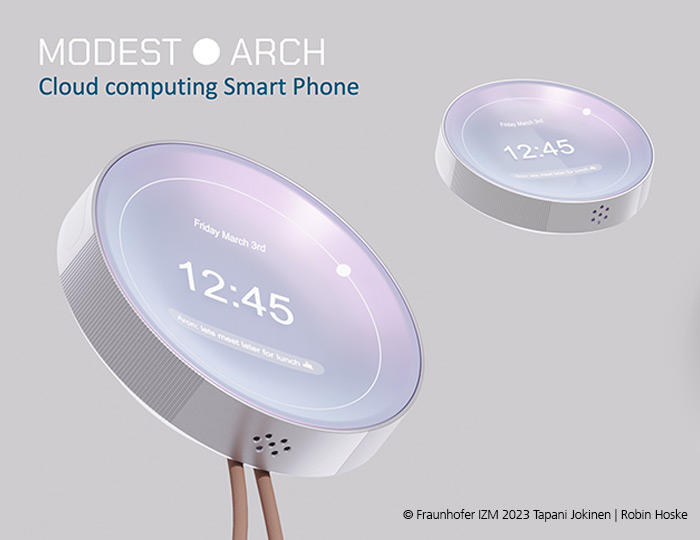
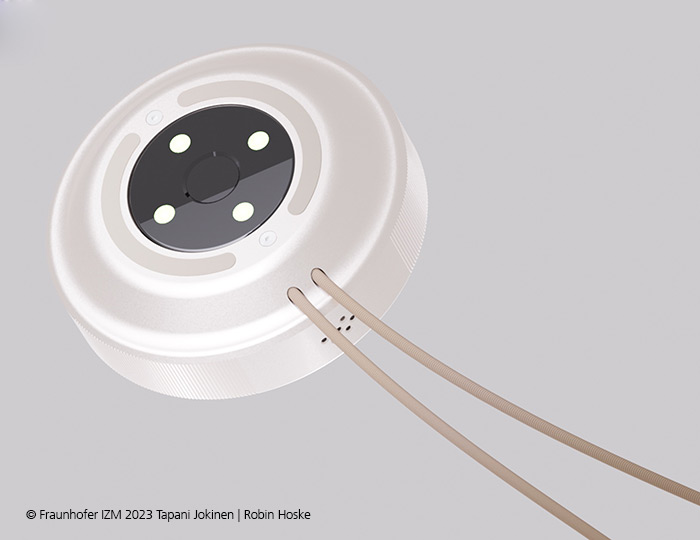
MODEST ARCH 3D render image
© Fraunhofer IZM 2023: Tapani Jokinen & Robin Hoske
Together with Hoske, Jokinen assumes that in the future, thanks to 5G cloud computing, numerous collaborative screens will be available in public spaces. Through them, users will be able to access, share, and interact with cloud services and cloud data at any time. Installing and updating apps on local devices will become obsolete.
“In the next 10 years, many applications will work via virtual reality and AI-based voice assistants. That’s why we opted for a compact and minimalist design,” says Hoske, explaining the decision to keep the hardware in the phone’s body to a minimum. All essential hardware elements that are normally integrated as fixed components in a smartphone were outsourced. The need to update the device hardware is eliminated. At the same time, this opens up creative freedom for its design.
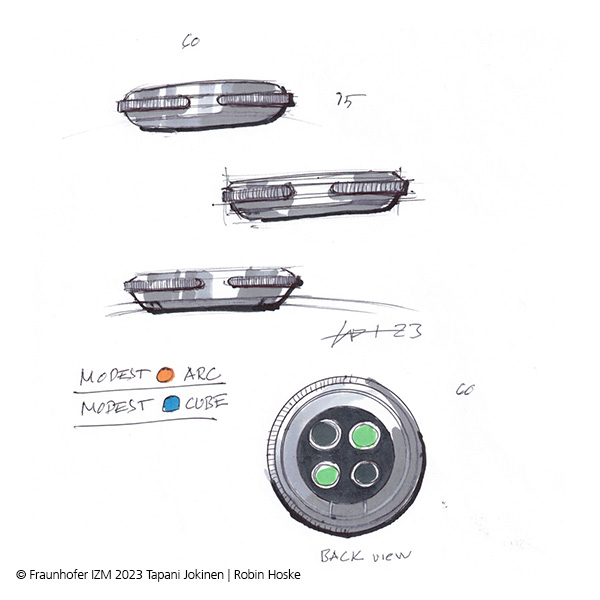

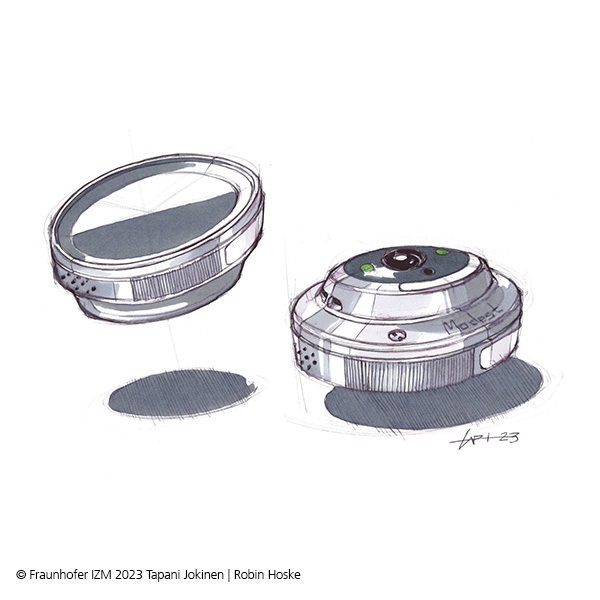
Sketches of the reinvented smartphone of the future: MODEST ARCH
© Fraunhofer IZM 2023: Tapani Jokinen & Robin Hoske
Strikingly, the decision allows a round interface. By contrast to common smartphone models, the MODEST ARCH is compact, with a size of 51 x 15 mm. The highlight is its shape and pocketable size, which is perfectly adapted to the ergonomics of the human hand and allows easy, single-hand operation.
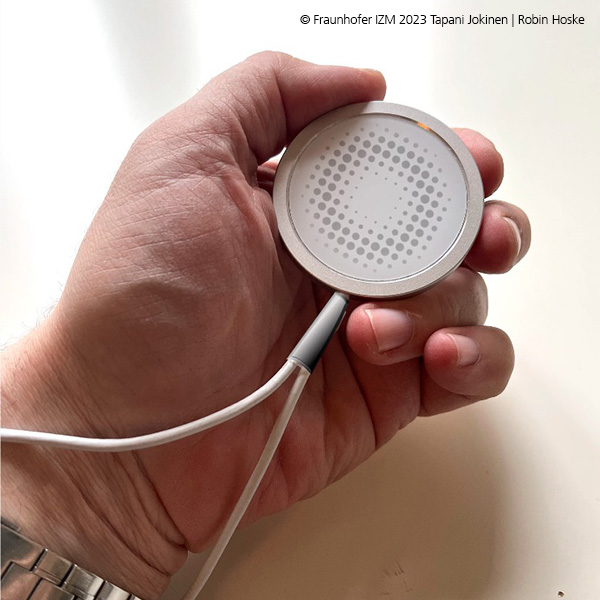
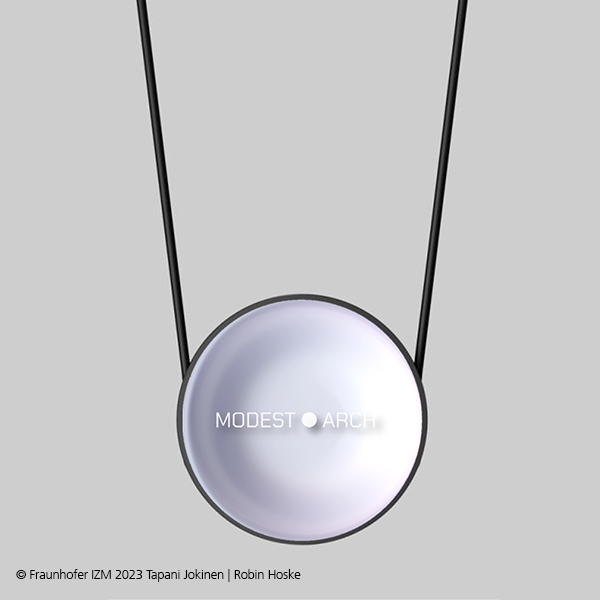
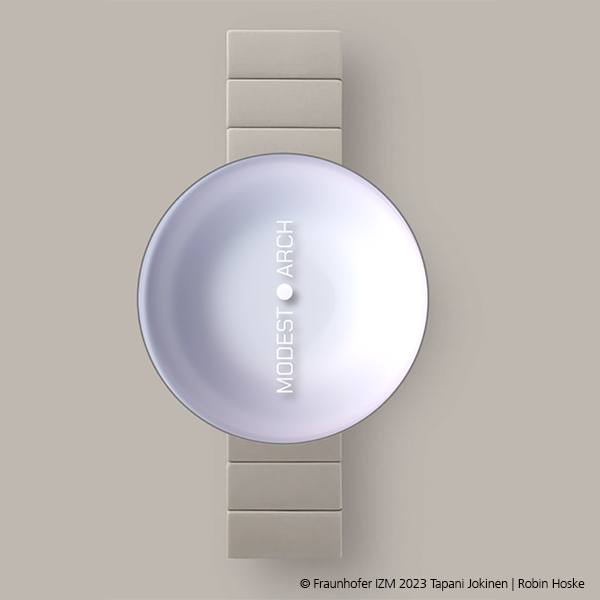
Ultra-mobile device – whether as a bracelet, necklace, brooch – the MODEST ARCH can be worn flexibly.
© Fraunhofer IZM 2023: Tapani Jokinen & Robin Hoske
The touchscreen is – following the natural curvature of human fingers – slightly curved inwards. Part of the outer ring is given a textured surface to ensure a better and more secure grip. Capacitive patches enable off-screen interactions.
The round shape of the device is reflected in the user interface. On the touchscreen, users select functions via a rotating carousel menu. The volume can be adjusted by turning the casing ring. Calls are answered by pressing the bezel.
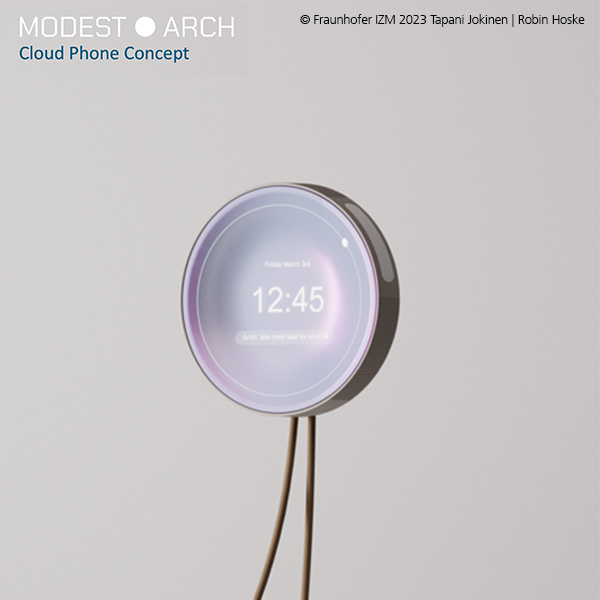
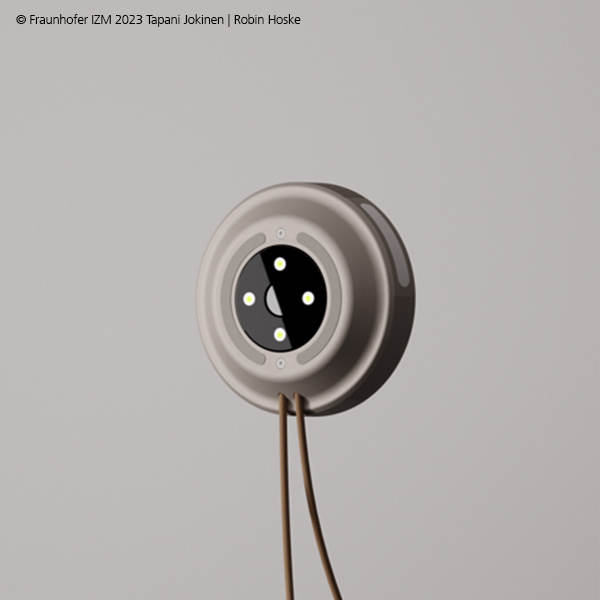
Front and back of the MODEST ARCH
© Fraunhofer IZM 2023: Tapani Jokinen & Robin Hoske
“We are aware that this poses a major challenge. Certain visual elements and displays are more difficult or impossible to integrate into the round interface. Our main concern was to reduce the potential sources of distraction and interruption for users with a feature set reduced to the essentials”, explains Tapani Jokinen.
At the same time, there are unique opportunities in how functions are implemented. “For map and satnav applications, we can use tactile-haptic feedback in the form of vibrations to guide users,” says Tapani Jokinen. The design of MODEST ARCH is inclusive and minimizes potential risks. Not everyone wants to be identified as unfamiliar in an unfamiliar environment. Instead of navigating with a smartphone in hand for all to see, as has been the case in the past, the MODEST ARCH allows for discreet orientation, while a gyroscope, GPS, and accelerometer track the device’s movements. The MODEST ARCH’s equipment also includes a high-resolution camera and numerous health sensors to measure, for example, an optical heartrate or blood oxygenation sensor.

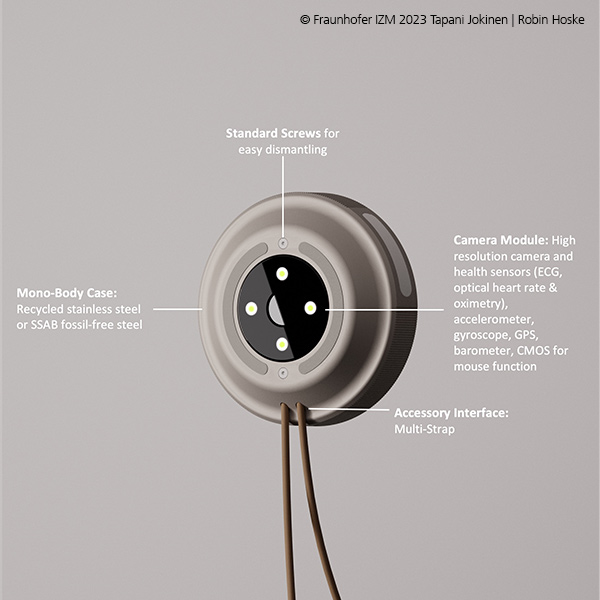
Configuration and functions of the MODEST ARCH
© Fraunhofer IZM 2023: Tapani Jokinen & Robin Hoske
A universal remote control for IoT environments
Repairability, durability, and sustainability also play a role in the design of the MODEST ARCH. High-quality materials are used to promote a long working life. A shell made of recycled stainless steel or fossil-free SSAB steel, combined with a Victus Gorilla bulletproof glass screen, protects the smartphone from damage. If necessary, the case can be opened with a standard screwdriver to quickly and easily replace the battery or individual parts.
The MODEST ARCH is designed for interactive and convertible use. It is best to think of the device as a universal remote control for IoT environments. Depending on the actual needs and occasion, users can connect the MODEST ARCH to different user interfaces anytime, anywhere to add more functions or share data and content across multiple screens and devices. The 5G cloud-based device can be configured as needed and used for a variety of applications.
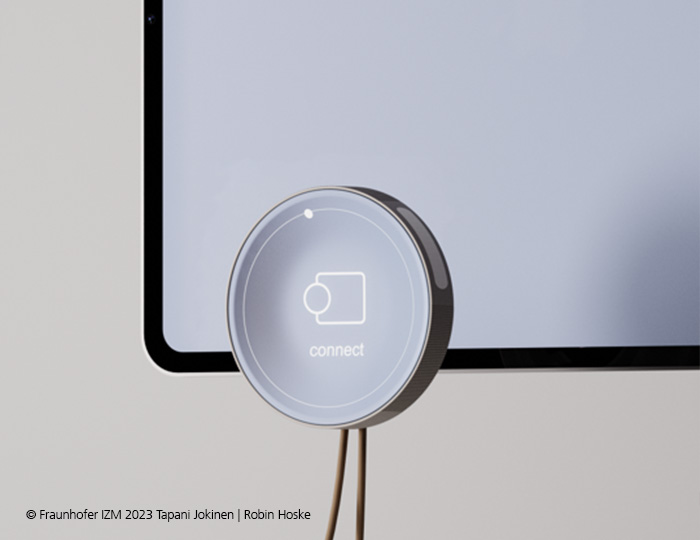
The MODEST ARCH relies on networking with other audio-visual surfaces
© Fraunhofer IZM 2023: Tapani Jokinen & Robin Hoske
In addition to the usual functions such as phone, camera and alarm clock, the researchers have thought of new uses that are possible specifically due to the design of the MODEST ARCH. Thus, it can also be used as a PC mouse thanks to CMOS, which transmits the movement on a surface to a screen. Motion sensing technology also enables the use as an air mouse or controller for games.
Application possibilities and functions of MODEST ARCH at a glance:
1. Basic functions: Reminders, notifications, phone, messaging, and entertainment, high-resolution camera, access to basic apps and AI assistant.
2. Health and fitness tracker for measuring and analyzing vital signs.
3. Sports tracker for outdoor activities
4. Haptic navigation and compass for pedestrians and cyclists
5. Universal remote control/ IoT multi-hub for smart home, smart office and smart entertainment ecosystems
6. PC mouse or touchpad for the workplace
7. Air mouse for augmented reality applications and spatial computing or controller for games
8. Internet hotspot
9. Digital ID and access key
10. Radio (alarm clock) in the bedroom
Environmentally friendly electronics: pioneering work in circular design
“When developing the design concepts MODEST CUBE and MODEST ARCH, we applied the methods and tools of the Circular Design Toolkit developed at Fraunhofer,” Jokinen summarizes. The Circular.Design Toolkit helps product designers, constructors, and entrepreneurs create economically and ecologically balanced concepts – from product design to services to business models. “Our work will serve as an inspiration to the research community on how to design environmentally friendly electronics without sacrificing function or form.”
Jokinen and Hoske firmly believe that the future will be circular and linear business models will be a thing of the past. They predict that new distribution channels and forms will be reflected in electronics design and related services in the future. They see the development of economically and ecologically balanced products as an opportunity to open up new business areas.
MODEST CUBE and MODEST ARCH are visions of the future that still exist only on paper. “It would be appealing as a follow-up to our MoDeSt research project to build both smartphone prototypes together with manufacturers and industry partners,” explains Professor Dr. Melanie Jaeger-Erben. To see how the two prototypes are received by users, the sustainability researcher could imagine a test scenario in a home lab or citizen science lab. Her wish is that both Fraunhofer Institutes and other research institutions invest more in participatory technology development. So far, many projects were limited to developing highly specialized technologies and processes.
“It would be great if, going forward, questions about direct interactions between users and technologies and everyday research had more weight in research,” says Jaeger-Erben. “In the long term, setting up a Citizen Science Lab in Berlin or at the Cottbus site would be a cool thing.”
The joint MoDeSt project was funded by the BMBF as part of the “Resource-efficient circular economy – Innovative product cycles (ReziProK)” initiative.
– Funding code: 033R231
– Duration: 01.07.2019 – 30.06.2022
– Participating partners: Fraunhofer IZM, TU Berlin (later BTU Cottbus-Senftenberg), Centre for Sustainability Management (CSM) of Leuphana University Lüneburg, Integrated Quality Design (IQD) of Johannes Kepler University Linz (associated), SHIFT GmbH and AfB gGmbH.
This could be interesting for you:
Part 1 and 2 of part of the RealIZM blog series “Integrative Circular Economy”
- What makes modular smartphones sustainable for different user groups?
- MODEST CUBE: A vision of sustainable smartphone product design
Subscribe to RealIZM Newsletter!
Get the latest insights into electronic-packaging and innovative technologies in microelectronics deliver


